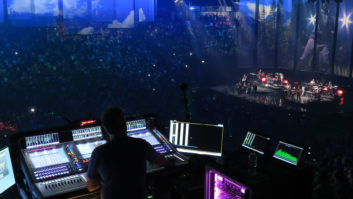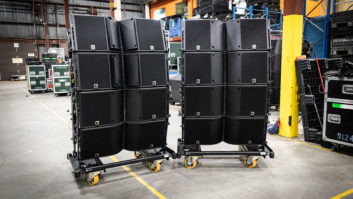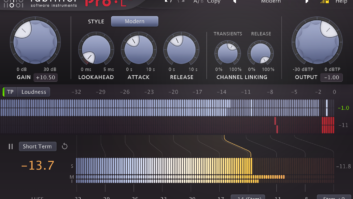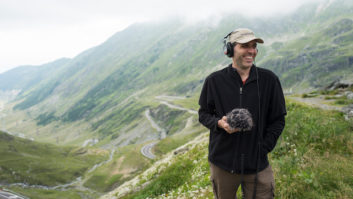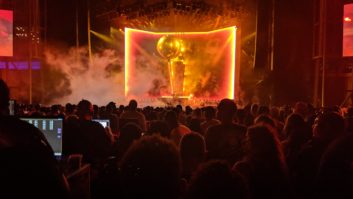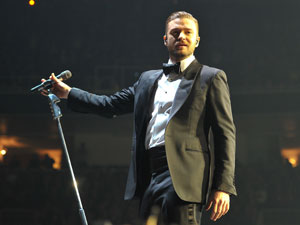
Justin Timberlake’s 20/20 Experience tour landed in the SAP Center in San Jose, Calif., in January 2014.
Photo: Steve Jennings
When Mix caught Justin Timberlake at the SAP Center in San Jose late-January, he was already nearing the end of his first U.S. leg and about to head off to Europe from March to June, before returning to the States for a run through August. That’s more than a year on the road, but for the crew, it’s the third incarnation of the setup and just the middle of a two-year commitment that began back in January 2013 when they flew out to rehearse for that year’s Super Bowl and Grammy performances.
That was followed by random shows and promos around the world, then the Jay-Z co-headlining stadium tour in summer 2013, where a couple more pieces were added to the 16-piece band, then back to JT in arenas. While they have been fun shows to build, says FOH engineer Andy Meyer, they have been massive undertakings back to back. “Justin has a complete vision of the entire production,” says Meyer, who has been working with Timberlake since 2005. “He might come by while we’re running something and suggest, say, turning a snare sample that the drummer is triggering up 1 dB and as always it makes the song! Not only does he know exactly how he wants it to sit in the mix, he [also] has such an excellent ear. This gives me exceptional information. I wish every artist could be this musically knowledgeable and involved.”

Front-of-house engineer Andy Meyer, at the DiGiCo SD7, has been working with Timberlake since 2005.
Photo: Steve Jennings
It is a Justin Timberlake show, and Meyer is well aware that the audience comes for the performance and wants to hear every word. He provides the clean path and JT does the rest. “Justin is a traditionalist—microphone in hand, no headset, he understands proximity effect and he uses it to his advantage,” he says. “We’ve chosen to go analog with him to FOH. He uses an Audio-Technica 6100 hypercardioid dynamic handheld microphone, which has great rejection qualities. I bring it analog to FOH into a [Rupert Neve Designs] Portico II channel strip and that’s my mic pre. From there it goes into the Apogee Symphony and that converts it to digital, then it goes AES into the console. It warms him up nicely. There’s also a great de-esser circuit in the Portico II channel. Finally, in the console I use the Waves C6 and H-Comp plug-ins.”
The console is a DiGiCo SD7, which he’s been running for about two years, originally spec’ing it for its high input count capabilities, and now taking advantage of its sound and integration. “I’ve tried to integrate analog gear with other digital consoles and it never really sounds as good as it has with the SD7,” he says. “I attribute that to their converters. So I’ve gone one step further where I’ll use the D/A converter out of the console into insert gear, and then I’ll send that analog out into a Symphony I/O returning it back into the console AES so I can bypass the sample rate conversion on the desk. That’s how I find it really sounds best.”
“I’ve got a Rupert Neve Portico II master bus processor, a Dangerous [Music] Bax EQ, and a DTC MindPrint inserted on the master bus. I have some Vintech 473 preamps in line mode that I insert on bass guitar, snares and guitars which gives it a nice midrange punch. The heart of my rig is the Antelope Audio 10M, Orion, Trinity combination I’m using to clock the entire system. That’s what glues it all together.”

Monitor engineer Dan Horton also uses a DiGiCo SD7.
Photo: Steve Jennings
Solotech is providing the L-Acoustics P.A. for the tour, with 16 K1s per side, six KARAs per side for down fill, and 12 K1 SBs per side to supplement low end in the air. For side hang there are 12 K1s and six KARA per side, and for the 270 hang they have 12 KARA on both sides along with eight 108s in different spots for front fills. Etienne Lapre is systems tech. Monitor engineer Dan Horton is also on an SD7, and has been for about four years, switching over from the D5 when he found himself using two to cover his needs.
“One of the things I like the most about the SD7 is the sound quality with total flexibility to match,” Horton says. “My favorite is the subgroup dynamics and insert capabilities. I have separate subgroups for each instrument section: drums, percussion, bass, guitars, keys, background vocals, JT instruments, JT vox and JT effects. I do all the subgroups to a band subgroup (Empirical Labs Fatso on insert), which goes to a master subgroup alongside my main JT vocal subgroup. Master is JT’s mix (SSL XLogic G Series Bus comp on insert). Our bass player is our musical director and he doesn’t like a lot of compression, so I leave a channel flat to him. But then when I send it to the group I get to EQ it differently. I use the DiGiCo onboard multiband comp to just control dynamics and then the next onboard comp in that group to act as the compressor of the group. I also have 12 talkbacks so band members can talk to me during the show.”

Photo: Steve Jennings
Horton clocks his system with an Antelope Trinity and 10M combination. Outboard gear includes Bricasti M7s for reverbs and a couple of Eventide Eclipses—one for a distortion sound and one for a phaser sound. For the solo portion of this year’s tour, he added API 512c mic preamps into Timberlake’s chain, along with Retro Double Wide compression to add a little more depth to his vocal, “a little more 3-D.”
Timberlake and most of the band are using JH Audio JH16 in-ear monitoring systems. The wireless system is 24-channel Shure PSM 1000, with singers and horns on Shure Axient.
“He can really sing, and he can actually mix his own stuff, can call his own frequencies,” Horton says. “He’s no slouch when it comes to sound.”
